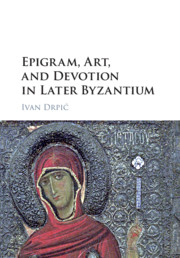In the winter of 1293–94, the celebrated scholar and monk Maximos Planoudes sent a letter to a friend, the monk Melchisedek, son of the statesman and historian George Akropolites.Footnote 1 The letter opens with a complaint. Writing from Constantinople, Planoudes confesses how much he longs to visit the addressee, who was in Asia Minor at the time, but winter with its harsh weather does not allow him to set sail. Despite the fact that he praised this season abundantly in his writing, it is ungrateful and responds with threats; truly, he points out with regret, winter is deserving of invective rather than encomium. Spring, on the other hand, is benevolent and sweet. Although he judged it inferior to winter, it bears no malice.Footnote 2 It will bring fair weather, calm sea, and winds favorable to navigation. After this epistolary jeu d’esprit, Planoudes turns to the main subject of the letter. He had been commissioned by Melchisedek to compose verse inscriptions for an icon of the Last Judgment, most likely a panel intended for the addressee’s private devotions, as well as to write some sort of commentary on them. Planoudes now presents the products of his verbal artistry and informs Melchisedek that he has failed to respond to the second task.
Ἅς γε μὴν κελεύετε τῆς εἰκόνος ἐπιγραφάς, πεπόμφαμεν ἤδη ποιήσαντες· αὗται δ’ ἔπη λέγοιντ’ ἄν, εἴτ’ οὖν ἡρῷά τε καὶ ἑξάμετρα, οἴκτου μεστὰ τὰ πλείω· τούτων γὰρ ὑμῖν ὡς πρὸς τὴν μέλλουσαν κρίσιν (ἧς δῆτα καὶ ἡ εἰκὼν δεῖ) γράφειν τι καὶ τῶν πεμφθέντων ἕνεκεν, ὃ καὶ ἀπαιτούμενον ἦν, ἠβουλόμην· συνιδὼν δὲ κινδυνεύοντα τὸν λόγον ἐξενεχθῆναι πρὸς τὸ ψυχρότερον ἐμαυτὸν αὖθις ἐπέσχον.Footnote 3
I have composed the inscriptions for the icon, which you indeed requested, and now I am sending <them to you>. These may be called epic verses, that is, heroic hexameters; for the most part they are full of <requests for> compassion. For this reason and with regard to what has been sent, as was your demand, I wished to write to you something <about these verses> in anticipation of the future judgment <of them> (which, certainly, the icon is in need of as well!). However, noticing that my discourse was at risk of becoming too insipid, I restrained myself immediately.
Enclosed with the letter were three epigrams in hexameters composed to accompany different parts of the icon, which – in iconographic terms at least – must have resembled a roughly contemporary icon of the Last Judgment at Sinai (Figure 1.1).Footnote 4 The first epigram is devoted to the portrayal of Christ in glory, surrounded by the apostles and angels and the interceding Virgin and John the Baptist. The verses confront the viewer with the terrifying vision of the eschatological tribunal and, in a series of rhetorical questions, urge him to repent.
Judgment! Assembly! This formidable spectacle! Here presides God who judges every deed. Will you not tremble while gazing <at him>? Will you not shed warm tears? Man, will you not set your life straight? For this is how it will happen.
In the second epigram on the depiction of the damned in Hell, the viewer, now overcome with fear, asks Christ:
With what kind of punishments, O Savior, do you threaten me, the sinner? Even the ones painted on panels terrify me. I tremble at the prospect of experiencing them; the very sight of them frightens me.
The final epigram concerns the representation of the righteous. Turning to the choirs of saints and to the scene of Paradise, which, as in the Sinai icon, featured the enthroned Virgin, Abraham with the souls of the righteous, and the Good Thief, the viewer exclaims:
May nothing ever happen to separate me lamentably from your lot, O flock of saints! Rejoice, O Queen [i.e., Virgin], and you, father Abraham, and I also address the penitent thief: if it is right, allow me to inhabit the farthest quarters of Paradise.
Elegant, interactive, suffused with dramatic pathos and appropriately admonitory in intent, Planoudes’ hexameters offered themselves as an apt poetic accompaniment to a personal devotional image of the Last Judgment. Nonetheless, they were to be scrutinized and evaluated by the addressee and, presumably, by his circle of friends – those to whom, in keeping with the protocols of Byzantine epistolary culture, Melchisedek would read the letter at a small literary gathering, the so-called theatron.Footnote 5 In a playful allusion to the icon’s subject, the writer anticipates the future judgment of his verses and also recommends the icon itself for critical appraisal.
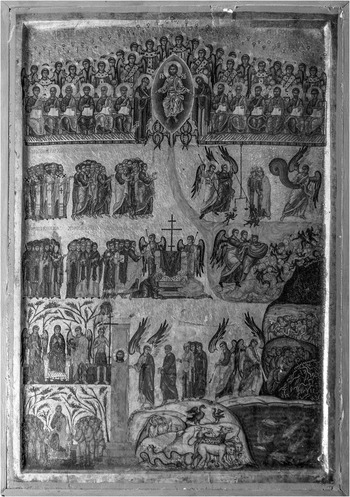
Figure 1.1 Icon of the Last Judgment, c. 1260–80, Saint Catherine’s monastery, Mount Sinai
Planoudes’ letter affords us a precious glimpse into the social and intellectual context in which epigrams were commissioned, written, read, circulated, and commented upon in Later Byzantium, the context in which art and poetry, devotion and aesthetic appreciation converged. The present chapter sets out to illuminate this context. In what follows, I shall first offer some brief remarks on the notion of epigram as logos, introduce the meters used in Byzantine epigrammatic poetry, and highlight some of the challenges one encounters when dealing with epigrams preserved only in manuscripts. Then, turning to the issues of artistic and literary patronage and production, I shall locate the process of creating objects inscribed with poetic texts within a broader social arena and examine the roles played by the patron, the poet, and the artist – the key figures in this process. The final section of the chapter shifts focus to the questions of reception and considers different modalities of engagement with the inscribed verse, with an emphasis upon the oral performance of epigrams.
Why verse? Epigrams and the power of logos
Melchisedek’s decision to commission Planoudes to compose verses for the icon of the Last Judgment followed what Paul Magdalino has aptly termed the “epigrammatic habit.”Footnote 6 Many elite Byzantines had their personal icons and other devotional artifacts inscribed with poetic texts. This was by no means a routine element of artistic patronage. In fact, the vast majority of Byzantine artifacts that have come down to us have no inscriptions attached to them, apart from the ones required by the iconographic tradition – identifying labels, for instance. Besides, the commissioner of an object could choose to have it inscribed with a much more pedestrian kind of text. A mid-fourteenth-century icon of the Last Judgment in the Kanellopoulos collection at Athens features a short run-of-the-mill dedicatory note, which reads Δ[έη]σις τοῦ [δούλου τ]οῦ Θεοῦ Ἰωά[ννου καὶ τῆ]ς σ[υμ]βίου α[ὐ]τοῦ Μαρίας (“Prayer of the servant of God John and of his wife Maria”), strategically displayed next to the image of the Hetoimasia with the praying figures of Adam and Eve at its foot.Footnote 7 Despite the ubiquity of the epigrammatic habit, verse inscriptions always represented but a fraction of the entire epigraphic production in Byzantium, with prose being by far the more common, if less elevated, medium of written display.
For the Byzantines, however, the choice of poetic form carried a distinct charge. To attach a set of verses to an object was not simply to inscribe it with a text, but to furnish it with a piece of logos. Χρυσὸς κοσμεῖ δάκτυλον καὶ ψυχὴν λόγος (“Gold adorns the finger and logos <adorns> the soul”). Thus reads a poetic motto carved in relief around the hoop on a fourteenth-century gold ring with a crowned eagle on its bezel, now in the National Archaeological Museum at Athens (Figure 1.2a–b).Footnote 8 If a piece of jewelry enhances the body, what ornaments the soul – so the motto self-referentially proclaims – is logos, that is, the epigram displayed upon it. Elegantly and rather playfully, this monostich encapsulates a view on the rapport between the physical artifact and inscribed verse that was common in Byzantium. To be sure, the opposition that the motto sets up between chrysos (“gold”) and logos – note that the two words are placed at a remove from each other, occupying the extremities of the verse – has an unmistakably moralizing undertone. The care for the external appearance is here opposed to the care for the inner self. But implicit in this juxtaposition of the outer and the inner is the idea that the gold ring and the verse inscribed upon it are bound together and, not unlike body and soul, locked in a symbiotic existence. Their cohabitation, however, is organized on a hierarchical principle, structured along the lines that separate the material from the spiritual and the sensible from the intelligible. Both the ring and the monostich are identified as valuable possessions, articles of personal adornment. Yet, whereas the precious metal signals sensual beauty and material affluence, the string of words carved around the ring’s hoop points to the wearer’s intellectual refinement and his dedication to what the Byzantines referred to as logoi, a term that probably comes closest to the modern notion of literature.Footnote 9
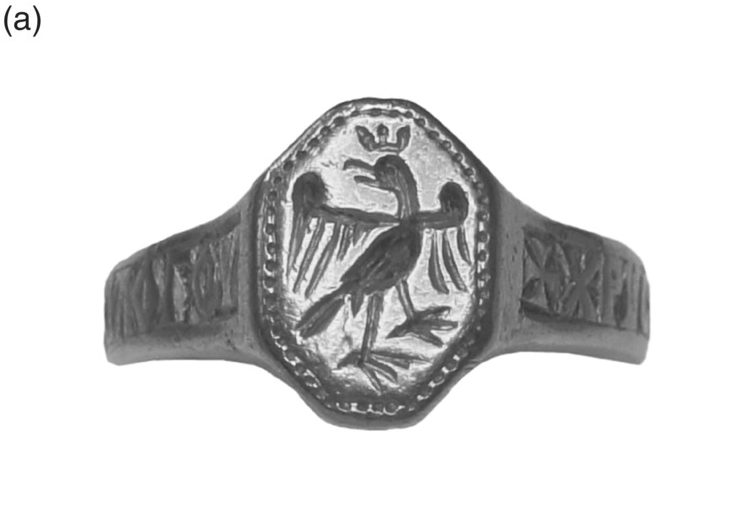
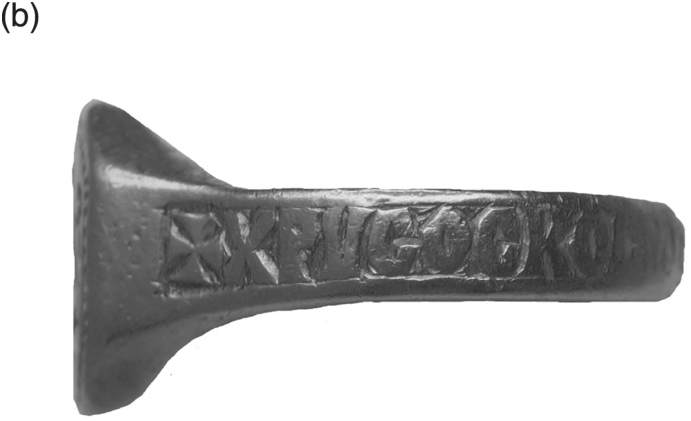
Figure 1.2a–b Ring, fourteenth century, National Archaeological Museum, Athens
The choice of poetic form for an inscription should not be reduced to a declaration of literary interests, however. It bears emphasizing that in Byzantine culture logos was a pregnant concept invested with a profound spiritual and even mystical significance. The term covered a vast semantic field. It could be translated as “word,” “speech,” “discourse,” “reason,” “commandment,” and “law,” among other things, but it could also signify Christ as the Divine Logos, the Word made flesh.Footnote 10 The understanding of epigram as an instantiation of logos partook of the term’s rich polysemy and its many religious and intellectual connotations. The notion of epigram-as-logos endowed the act of placing a poetic text upon an object with solemnity, force, and spiritual luster, and rendered it a potent gesture.
In epigrams, logos manifests itself in poetic form and is structured according to the principle of metron, or meter. Planoudes’ choice of hexameter for the inscriptions on Melchisedek’s icon is notable because this meter is rarely used in Byzantine epigrams. The elegiac distich, the usual meter of ancient epigrams, is equally rare, while the fifteen-syllable “political” verse is encountered only exceptionally, despite its great popularity in Byzantine poetry from the eleventh century onward.Footnote 11 The vast majority of Byzantine epigrams make use of the dodecasyllable, the medieval Greek equivalent of the ancient iambic trimeter.Footnote 12 Reflecting the disappearance of the distinction between long and short syllables in Greek that had happened well before the advent of the Byzantine millennium, unlike the iambic trimeter, the dodecasyllable is essentially an accentual rather than prosodic meter. Its characteristics include the prescribed line-length of twelve syllables, a strong caesura – the so-called Binnenschluss – after the fifth or the seventh syllable, and an obligatory stress on the penult. To these characteristics should be added a general avoidance of enjambment, which accounts for the fact that most poetic pieces in the dodecasyllable consist of a succession of short phrases, with each line forming a logical and syntactical unit. The dominant use of paratactic syntax, coupled with the increasing emphasis on rhythm, made this kind of poetry easy to comprehend and absorb. The Byzantines appreciated the dynamic structure, rhythm, and rapid movement of dodecasyllables, which they simply called ἴαμβοι (“iambs”). Michael Psellos, for example, declared that the verses of George Pisides, one of the supreme models of iambic poetry in Byzantium, “leap forth as if shot from a sling.”Footnote 13 The thirteenth-century treatise On the Four Parts of the Perfect Speech singles out “rhythmical harmony” (εὐρυθμία) as the foremost quality of the dodecasyllable. This quality, as the anonymous author explains, is achieved by the compact intertwining of words and the absence of hiatus, as well as by stress regulation.Footnote 14
Hexameters lacked the vividness and acoustic immediacy of accentual dodecasyllables, because their prosodic patterns could not be comprehended aurally. Their appeal, however, lay elsewhere. Poetry composed in this “heroic” meter possessed a distinctly antique flavor, bringing to mind the great Homeric epics. Besides, the mastery and correct application of the rules of hexameter required considerable linguistic expertise.Footnote 15 The very fact that Planoudes chose this difficult ancient metron for the epigrams sent to Melchisedek must have enhanced their literary value in the eyes of an informed reader. Regardless of their content, the verses of the learned monk shone with an antiquarian luster that would have appealed in particular to those initiated in the more subtle mysteries of logos.
Verses on the page: epigrams in the manuscript record
Melchisedek’s icon of the Last Judgment has not survived, and we have no way of knowing whether Planoudes’ verses were actually inscribed upon it. The three poems have come down to us in the manuscript record, as part of the learned monk’s epistolary corpus. Countless Byzantine epigrams had a similar fate. Divorced from their original setting and the circumstances that prompted their creation, they have been preserved for posterity on account of their literary merit as autonomous, self-contained poetic compositions. Instead of the surfaces of artifacts and buildings, they came to inhabit manuscript pages, typically embedded either in single-author collections or in anthologies of epigrams written by different authors at different times, often combined with texts of other genres. Since this study makes copious use of epigrams transmitted in manuscripts, a few words about some difficulties inherent in dealing with the manuscript record are in order.
Very few Byzantine epigrams preserved in manuscripts can be also found as verse inscriptions in situ.Footnote 16 The rest are available to us solely as poetic pieces committed to paper or parchment. In the absence of direct evidence, we can never be sure whether an epigram found only on a manuscript page once existed as an actual inscription, or whether it was a literary composition never intended to be inscribed. Internal indicators such as the use of verbs of perception and deictic adverbs and pronouns, the inclusion of specific references to the iconographic, material, or technical aspects of an object, or the naming of the commissioner may imply that the epigram in question was indeed originally inscribed.Footnote 17 The titles added to epigrams in manuscripts are usually of little help in this regard.Footnote 18 They often consist of nothing more than the rather ambiguous preposition εἰς (“on”) followed by the subject of the epigram, as in Εἰς τὴν σταύρωσιν, which can mean either “<Verses written> on <the subject of> the Crucifixion” or “<Verses inscribed> on <an image of> the Crucifixion.” Occasionally, a title can be more informative and can even provide details that are otherwise missing from the poem itself. A case in point is an epigram copied in the Anthologia Marciana with the following title:Footnote 19
Εἰς τὴν εἰκόνα τοῦ ἁγίου Γεωργίου, γραφέντος ἄνωθεν τοῦ πυλῶνος τῆς τοῦ ποιήσαντος τοὺς παρόντας στίχους οἰκίας· ὅτε ἐμπρησμοῦ γεγονότος καὶ καυθέντων πάντων τῶν ἑταιρικῶν οἰκημάτων τῶν πλησιαζόντων τῷ ναῷ τοῦ ῥηθέντος ἁγίου τῷ συνηνωμένῳ τῇ τοιαύτῃ κατοικίᾳ, διεφυλάχθη αὕτη παντελῶς ἀβλαβής.
On the image of Saint George depicted above the entrance to the house of the one who wrote the present verses; <the image was set up> when the house remained completely untouched by a fire that broke out and burnt all the brothels near the church of the said saint, which is adjoining this house.
Attributing, expectedly enough, the fire’s outbreak to the saint’s miraculous intervention, the epigram recounts the incident in somewhat vague terms, without providing any information on the location of the image. The concluding lines voicing the plea of the owner of the spared house, who also happens to be the author of the epigram, simply state:
Thus, so that this miracle may not be forgotten due to the passage of time, I depict you, George the firefighter, asking you to put out the fire of Hell for me too.
It is probable that the verses were inscribed above the entrance to the house, next to the image of the saintly “firefighter,” but again, we cannot be certain.
The problem of determining whether an epigram copied in a manuscript was ever attached to an object is further complicated if we consider the epigraphic record. Many of the epigrams found in situ do not “look like” inscriptions at all; had they been transmitted in manuscripts, we would have hardly classified them as potential inscriptions. Similarly, poems that had been written with no inscriptional use in mind could end up as inscriptions. A good example is Psellos’ allegorical interpretation of the enigmatic parable of the leaven in Matthew 13:33 and Luke 13:21.Footnote 20 There is nothing about this poem that makes it particularly suitable for an inscription; yet it turns up, in abridged form (vv. 1–5, 10–11), in the apse of the late thirteenth-century cave church of Saint Andrew the Hermit near the village of Chalkiopouloi in Acarnania.Footnote 21 This example alone suffices to alert us that we should not be too reluctant to accept the possibility that an epigram with no overt inscriptional features could have been inscribed once.
A separate problem when dealing with the manuscript record concerns the length of certain epigrams. The Anthologia Marciana contains a poem on a precious belt, which Maria of Antioch, the second wife of Manuel I Komnenos, presented to the emperor, probably on the occasion of their wedding in 1161.Footnote 22
I, co-empress and royal offspring Maria, offer you this belt, which I have fashioned with pearls, precious stones, and gold, my emperor, treasure of my life. The gold is a token of my pure love; the <perfect> spherical form of the luminous pearls <symbolizes> my union with one person, with you and only you; and the solid precious stones proclaim the unbreakable <nature of this union>. May God gird up your strength and surround the earth with your power.
Portraying the costly materials used for manufacturing the belt as expressions of Maria’s affection and unreserved loyalty to her imperial husband, the verses were perfectly suited to accompany a conjugal gift. But was the epigram actually inscribed on the belt? Byzantine belts were typically made of leather or cloth and supplied with a range of metal fittings.Footnote 23 Judging by portraits of aristocrats and officials from the Palaiologan era, they could be quite long (see, e.g., Figure 3.19). But could the buckle of the emperor’s belt, a logical place for an inscription, accommodate ten lines in the dodecasyllable? Or should we perhaps imagine the text being divided into smaller units, each placed on a separate ornamental attachment? However, if the epigram was not inscribed, then what was its function? Was it perhaps recited at the formal presentation of the gift? This is certainly a possibility. In her study of the Anthologia Marciana, Foteini Spingou has suggested that a sizable portion of the epigrams included in this collection – as much as twenty percent of Syllogae B and C, in her estimation – consists of poems that were designed specifically to be orally delivered, rather than to be inscribed.Footnote 24 The length of the epigram relative to the available space on the object is only one of several indicators of this original function. The omission of the patron’s name, the emphasis on a specific occasion and a specific moment in time, strengthened by the use of such telltale words as νῦν (“now”), and the nature of the occasion itself (e.g., gift-giving), may equally point to the epigram’s performative function. Spingou has identified several possible contexts in which the recitation of such performative epigrams, as she calls them, could take place, including the ceremonial presentation of a gift by the donor or his or her representative; the reception of a gift along with a letter containing a set of verses composed to accompany the gift; and the reading and discussion of literary works, epigrams among them, in a theatron. We shall revisit some of Spingou’s propositions below in this chapter, where the performative character of epigrams in general – both poems ostensibly intended for oral delivery and inscriptions displayed on objects – will be addressed. For now, it suffices to stress that, as her analysis indicates, it is possible that quite a few among the epigrams transmitted in manuscripts were written primarily for vocal recitation.
The manuscript record thus presents us with a rich and complex textual landscape that is very difficult to chart. Actual verse inscriptions here mingle with probable performative epigrams and purely literary compositions with many gray areas between them. While in a number of instances the original function of a poem can be established with a greater or lesser degree of certainty, in many others we cannot do much else than guess.
Patrons, poets, artists
Maximos Planoudes’ letter to Melchisedek Akropolites documents one moment in the long history of interactions between art patrons and men of letters that made possible the creation of artifacts, spaces, and monuments furnished with verse inscriptions.Footnote 25 To be sure, not every epigram was the result of a commission issued by a patron. In the former monastic church of the Virgin Peribleptos at Ohrid, the archangel Gabriel is depicted in the narthex, next to the north entrance, with a pen and an inscribed scroll in his hands (Figure 1.3). The poetic message on the scroll, spoken in Gabriel’s voice, informs the visitor of the formidable task with which the archangel has been entrusted.Footnote 26
Holding the fast writer’s pen in my hand, I write down the promises of those entering. I protect the ones who keep them, but those who do not I swiftly destroy.
The possibility that the megas hetaireiarchēs Progonos Sgouros and his wife Eudokia Komnene, the founders of the Peribleptos monastery, commissioned these verses from a poet should be excluded. A more likely scenario is that Eutychios and Michael Astrapas, the two painters from Thessalonike who decorated the church with frescoes in 1294/95, lifted the verses from a painter’s guide or a model book.Footnote 27 Not only do the verses reappear some fifteen years later in a church at Spelies on the island of Euboea, again as a message uttered by Gabriel,Footnote 28 but the same text is recommended for the scroll of the archangel, when he is portrayed as a guardian next to a church entrance, in two post-Byzantine painter’s manuals.Footnote 29 As a matter of fact, most of the poetic inscriptions on scrolls held by holy figures in the Ohrid church are attested elsewhere.Footnote 30
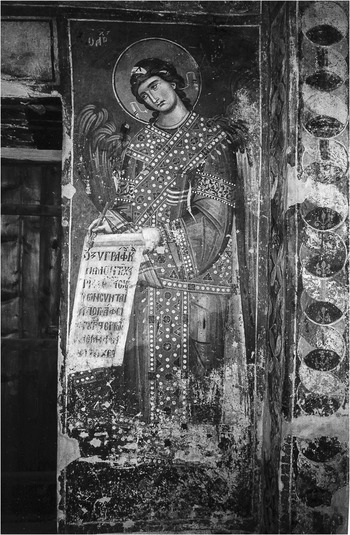
Figure 1.3 Archangel Gabriel, 1294/95, church of the Virgin Peribleptos, Ohrid
The poetic motto displayed on the ring in Athens (Figure 1.2a–b) presents a similar case. This dodecasyllable monostich turns up on three other gold rings dated to the Palaiologan period.Footnote 31 It has been argued that the four pieces come from the same workshop based in Constantinople, which produced jewelry for an elite clientele with ties to the imperial court. The monostich was likely part of the workshop’s catalog of ready-made verse inscriptions, from which a prospective commissioner with a literary bent could choose one to have engraved on his or her ring.Footnote 32
On occasion, the patron and the poet may be the same person. This was the case with the above-mentioned anonymous writer who, following a miraculous fire that razed brothels in his neighborhood, set up an image of Saint George above the entrance to his house and wrote an epigram to accompany it. Planoudes, to give another example, penned a quatrain that was probably inscribed on his personal enkolpion.Footnote 33 In the majority of instances, however, the creation of an object inscribed with an epigram necessitated a degree of collaboration between the object’s commissioner, its maker, and the poet employed to compose the epigram.
The Byzantine poet, as Floris Bernard has pointed out, is a problematic notion.Footnote 34 Poetry hardly existed as a separate intellectual activity, let alone a profession, in Byzantium. Instead, the writing of verse was subsumed within the larger domain of logoi. Educated men – and, exceptionally, women too – engaged in composing texts in metrical form, epigrams included, in addition to their other intellectual activities. Planoudes, for example, was primarily a scholar, teacher, translator, and scribe.Footnote 35 His epigrammatic opus is relatively small, and his principal engagement with this genre of poetry was in his capacity as a compiler and editor rather than author. To him we owe the monumental edition of about 2,400 ancient and Byzantine epigrams known today as the Anthologia Planudea.Footnote 36 Manuel Philes, a younger contemporary of Planoudes, was an intellectual of a different kind. Philes comes much closer to being a poet in the modern sense, as versifying was clearly his area of expertise and the basis of his reputation and livelihood. Since his epigrams will be of major concern to us, we must take a closer look at this intriguing figure.Footnote 37
Few Byzantine poets were as prolific, versatile, and sought after as Philes. Catering to an elite audience, his indefatigable pen produced a plethora of occasional verse, ranging from panegyrics and funeral laments to poems for feast days and ceremonial gatherings, accounts of historical events, and ekphraseis, in addition to over five hundred epigrams, a few of which can still be seen inscribed on objects.Footnote 38 Despite the fact that members of the imperial family of the Palaiologoi, including the emperors Andronikos II, Michael IX, and Andronikos III, were among the commissioners or recipients of his verses, Philes was never a court poet stricto sensu. And even though he is known to have participated in several diplomatic missions to the Golden Horde, Crimea, the Turkish-ruled Anatolia, and possibly elsewhere, he never held a salaried office in the imperial administration. Essentially, his livelihood depended on the generosity of his patrons. A host of aristocrats, military commanders, and civil and ecclesiastical dignitaries patronized Philes at various moments over his long career that lasted more than forty years, including the megas domestikos John Kantakouzenos (future emperor John VI),Footnote 39 the prōtostratōr Michael Doukas Glabas Tarchaneiotes and his wife Maria,Footnote 40 the sebastos Theodore Patrikiotes,Footnote 41 the prōtobestiarios Andronikos Palaiologos,Footnote 42 the megas stratopedarchēs Senachereim Angelos,Footnote 43 the domestikos of the Eastern themes Michael Atzymes,Footnote 44 the pinkernēs Syrgiannes,Footnote 45 and many others. A sizable portion of Philes’ oeuvre consists of petitions addressed to these illustrious individuals, in which the poet complains about his dire poverty. Fairly typical in this regard are the following verses sent to Senachereim Angelos.Footnote 46
Although you see me naked, my golden benefactor, you do not spread out the folds of your garments? But who shall warm my shivering body, O you who are truly the living light of life-giving serenity?
The poet’s obsequious appeals to his patrons often concerned food. Here is one addressed to a Palaiologan prince.Footnote 47
I am your dog, and you are my sweet master.Footnote 48 I bark, therefore, and beg to eat meat. O lion-hearted cub, feed your dog.
These and other similar requests for barley, fish, cheese, wine, and clothing leave the impression that the poet was a penniless savant reduced to destitution. As a matter of fact, Philes was no pauper. Born into a known aristocratic family,Footnote 49 he owned a landed estate, had a “Scythian” servant,Footnote 50 and was extravagant enough to request a male buffalo from the prōtostratōr Glabas to match the female one he already possessed.Footnote 51 Moreover, the kinds of rewards he received from his patrons – a silver-sheathed sword,Footnote 52 a gold-woven robe,Footnote 53 a goose-egg filled with silver coins,Footnote 54 horsesFootnote 55 – evidently point to a lifestyle befitting a wealthy man, not a famished wretch. If, despite this, Philes never tired of moaning about his indigence, it was because he deliberately cultivated the persona of a begging poet following the example of the twelfth-century literati.Footnote 56
The begging poet is a phenomenon of later Byzantine literary culture. As several scholars have argued, the emergence of this figure in the twelfth century reflects the anxiety of Byzantine men of letters regarding their ambiguous position in a shifting social landscape.Footnote 57 With the accession of the Komnenoi to the imperial throne, a new political regime was ushered in: a handful of aristocratic clans related to each other by blood and marriage effectively monopolized access to the sources of power and wealth. In the absence of an impersonal mechanism of promotion and demotion within the state apparatus and ecclesiastical hierarchy, the distribution of offices, titles, grants, and privileges came to depend increasingly upon a system of personal patronage. For many educated men of relatively modest origins, who were neither office-holders, nor clerics, entering the service of a powerful patron was the only route to social advancement. The status of these professional literati was, naturally, precarious. They did not belong to the ranks of the Komnenian elite; yet they shared its ideals of urbanity and learning, a cultural baggage that set them apart from merchants and artisans, practitioners of lesser trades whom the Byzantine upper classes traditionally held in disdain. In the twelfth century, however, a despised tradesman could fare better economically that a man of letters constantly in search of patronage. Education may have been one of the more potent instruments of social distinction in Byzantium, but it was also a “career investment”Footnote 58 fraught with risk. The tenuous social position of professional literati and their dependence on the patronage of the court and the aristocracy prompted them, in a sense, to cultivate a tone of exaggerated self-abasement. Thus, when Theodore Prodromos, one of the foremost literary figures of the Komnenian era, acknowledges his total reliance on the generosity of the emperor John II by saying, “If he gives me to eat, I live again, but if he does not, I am undone, I descend into Hades,”Footnote 59 the bluntness of his language is intentional. (Incidentally, we know that, like Philes, Prodromos enjoyed a fairly comfortable existence.)Footnote 60 What looms behind such crass declarations of poverty and complete submission is, in fact, an enhanced sense of personal merit and professional self-confidence. For, by giving vent to their plight, Prodromos and other “begging” poets implicitly advertised the value of their literary craft. As Roderick Beaton has aptly noted, “it is precisely because the poet is so indispensable as a singer of praises, or entertainer, or both, that his abject personal circumstances cry out to be remedied by a grateful benefactor.”Footnote 61 In short, self-abasement was a form of self-assertiveness.
In the social world inhabited by the Empire’s elite, occasions and venues that called for literary celebration were numerous. The poet’s skill was needed to enhance the glamour of court ceremonial, add verbal luster to religious festivals, immortalize military exploits, celebrate public inaugurations, and commemorate more private moments such as births, weddings, and funerals. It was also required to furnish buildings and artifacts commissioned by the notables with appropriate inscriptions in verse. The limited evidence at our disposal makes it very difficult to ascertain the nature of the patron’s involvement in the composition of an epigram. How often did this involvement go beyond rewarding the poet for his service? Was it common for the patron to give specific instructions to the poet or to suggest some general ideas, sentiments, or themes, which the poet would then develop and dress in verse form? A letter by the Late Palaiologan scholar John Chortasmenos shows that some patrons felt the need to be quite directly involved. The letter is addressed to a patriarchal official, Michael Balsamon, who mocked the verses Chortasmenos had composed for the newly built palace of the senator Theodore Palaiologos Kantakouzenos in Constantinople.Footnote 62
Concerning the words I wrote for the entrance <to the palace> of the most noble Kantakouzenos, which you find uncouth, he is to be blamed, not me. For this man is not easily persuaded to accept anything that appears to contradict whatever he may have said; rather, he believes that he is entirely capable of understanding the nature of everything in and of itself by using his innate intelligence, without the help of technical expertise [καὶ μὴ παρούσης τῆς τέχνης]. Should someone perchance try to discuss the matter at hand with him based on the principles of technical knowledge [κατὰ νόμους τεχνικούς], he acquiesces, albeit unwillingly, out of respect for the manifest truth, but nonetheless, does not give up his initial resolution. Hence, even to engage in an intense debate with him does not seem to help much.Footnote 63
Kantakouzenos’ hands-on approach was not limited to the poetic embellishment of his palace. As Chortasmenos hastens to add, “That this man supervises every work that is being done at his residence is confirmed by the builders of the residence. They took extreme care of the construction just to obey his orders; for, without his opinion, they were not allowed even to plaster a wall on their own.ˮFootnote 64 Kantakouzenos’ lack of technē did not prevent him from interfering with the work of his skilled employees, whether their expertise lay in the art of poetry or in the art of building. It was only appropriate, therefore, that Chortasmenos should ascribe the beauty of the palace to its owner in an epigram in which the palace itself sets out to applaud Kantakouzenos.Footnote 65
It may appear, perhaps, that the masons’ hands constructed me so skillfully that, as you can see, O stranger, I am truly a delight for human eyes. Yet, if anyone wants to learn the truth, let it be known that the one responsible for my beauty is that man himself, whom I am now fortunate to have as a master.
The strained syntax of these unwieldy lines may well have provoked ridicule.Footnote 66 It is not known, however, whether the poem was actually inscribed at the palace entrance. In addition to these verses, Chortasmenos composed four longer epigrams on Kantakouzenos’ residence, two in the dodecasyllable and two in hexameter, which could equally serve as inscriptions.Footnote 67
In fact, it was quite common for a poet to present his patron with a series of epigrams on the same subject, from which the latter could choose the most fitting to be inscribed.Footnote 68 Philes’ oeuvre provides ample evidence for this practice. To give but one example, in response to a commission from the statesman Michael Senachereim Monomachos to pen some verses on a gold ring, the poet produced six iambic couplets.Footnote 69
Dust bears dust – what source of pride could this be for Michael Senachereim Monomachos?
Michael Senachereim <adorns> the ring, and the ring adorns Monomachos.
Having no praise for Gyges, Monomachos does not take pride in the turn of the ring.
Gold dust, which enchants the simple-minded, teaches Senachereim to live in moderation.
I am yours, but in a moment I will become somebody else’s; for nothing is entirely stable in life.
To turn pale <even> before death is what threatens me, for I see that this ring’s gold is dead.
With a sententiousness reminiscent of gnomic poetry, Philes’ verses dwell upon the familiar themes of the brevity and uncertainty of human life and the transience of material riches, while simultaneously offering praise to his patron’s moral rectitude. Each couplet, however, is distinct. In allusion to Genesis 2:7, the first pithily reminds Monomachos that both he and the gold ring on his finger are nothing but dust. The second implicitly extols the patron’s excellence and virtue by claiming that he is an ornament to the ring as much as the ring is an ornament to him. In the third couplet, Philes introduces a learned reference to the story of Gyges, king of Lydia, and his magical ring which, when turned, made its wearer invisible.Footnote 70 Unlike this ancient villain, who succumbed to the temptation to abuse the power of his precious possession, Monomachos in his detachment from earthly concerns remains wholly impervious to the charms of the shiny trinket placed on his finger. The patron’s self-mastery is further celebrated in the fourth couplet, which draws attention to the perishable nature of gold. In the fifth, the ring itself is imagined speaking, reminding the wearer of the impermanence of human affairs. In the sixth and final couplet, the speaking voice is that of the wearer who cannot help but think of the morally corrupting sway of gold while looking at the ring.
Given that Philes’ couplets are admittedly generic in their themes and imagery, it does not seem necessary to postulate that the poet had an actual ring before him when he was composing these verses or that he was required to consult with the goldsmith in Monomachos’ employ. In all likelihood, he was simply asked to write a few lines suitable to be engraved on a ring made of gold. Presumably, when Philes presented Monomachos with a series of six poetic vignettes, the latter picked one and had it sent to the goldsmith. This appears to have been quite a common scenario. That the process of manufacturing an inscribed object did not necessarily involve a close and extended collaboration between the poet and the artist is indicated by curious mistakes encountered at times in the epigraphic record. A pectoral cross-reliquary of a ninth- or tenth-century date at Sinai provides a telling example (Figures 1.4 and 1.5a–d).Footnote 71 Made of copper alloy and adorned with scenes from the life of Christ and figures of saints rendered in niello and inlaid silver, this object consists of two crosses hinged together, which, thus combined, formed a receptacle for one or perhaps several now-lost fragments of the True Cross. A pair of poetic inscriptions runs in parallel along the narrow sides of the two crosses. The inscription on the front cross reads:
In the power of the venerable wood, protect, Christ, your servant Thomas.
The second inscription on the back cross contains a very similar petition followed by an odd phrase in prose:
Lord, Ruler, Creator of all, guard, protect your servant Thomas. And the rest in his drawing.
As Wolfram Hörandner has rightly pointed out, the puzzling phrase tucked onto the second inscription must have been a technical instruction to the artist, which he mistakenly engraved on the reliquary.Footnote 72 According to Hörandner’s hypothetical reconstruction of the sequence of events that led to the creation of this precious pendant, Thomas, the reliquary’s owner and presumably commissioner, made some sort of sketch detailing the images and identifying labels he wished to have placed on the pendant’s two faces. He then engaged a poet to compose a set of dedicatory verses to be inscribed on the object’s narrow sides. The poet produced two couplets and wrote them down on a piece of paper along with the note καὶ τὰ λοιπὰ ἐν τῇ γραφῇ αὐτοῦ (“and the rest in his [i.e., Thomas’] drawing”), an instruction for the artist to decorate the object according to the patron’s design. Assuming that the note was part of the poetic text, the artist engraved it. This may not have been the only mistake on his part. The fact that the two couplets share an identical hemistich – Θωμᾶν τὸν σὸν οἰκέτην (“your servant Thomas”) – suggests that they were composed as two alternative versions, only one of which was meant to be inscribed. Be that as it may, it is clear that the Sinai cross-reliquary did not receive its poetic embellishment under the poet’s watchful eye.Footnote 73
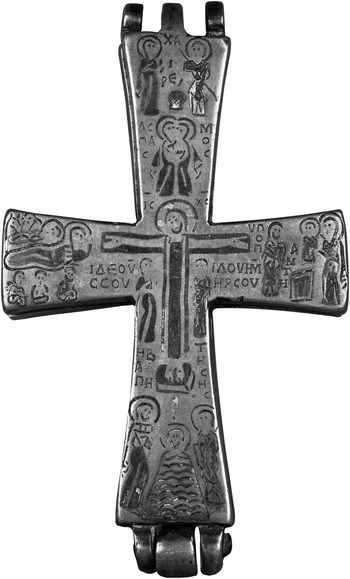
Figure 1.4 Pectoral cross-reliquary, ninth or tenth century, Saint Catherine’s monastery, Mount Sinai

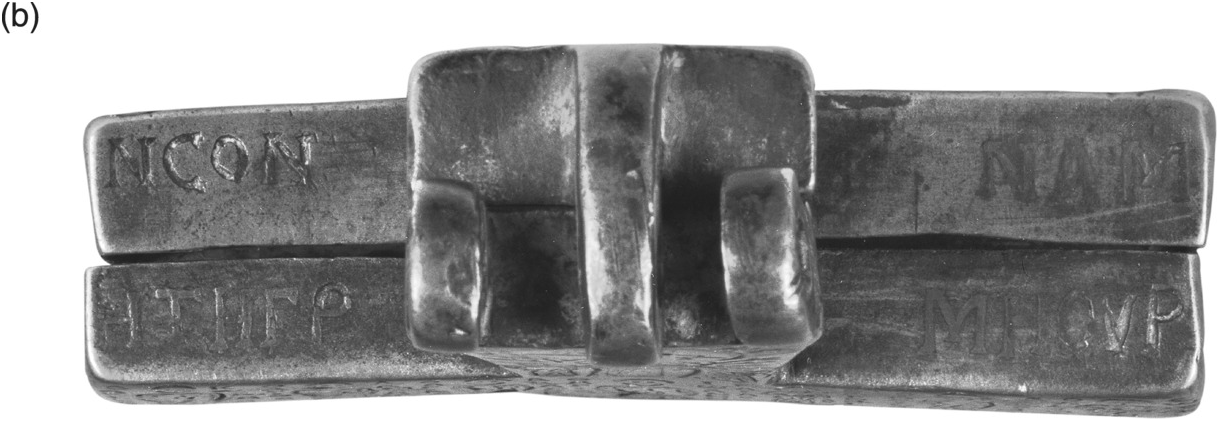
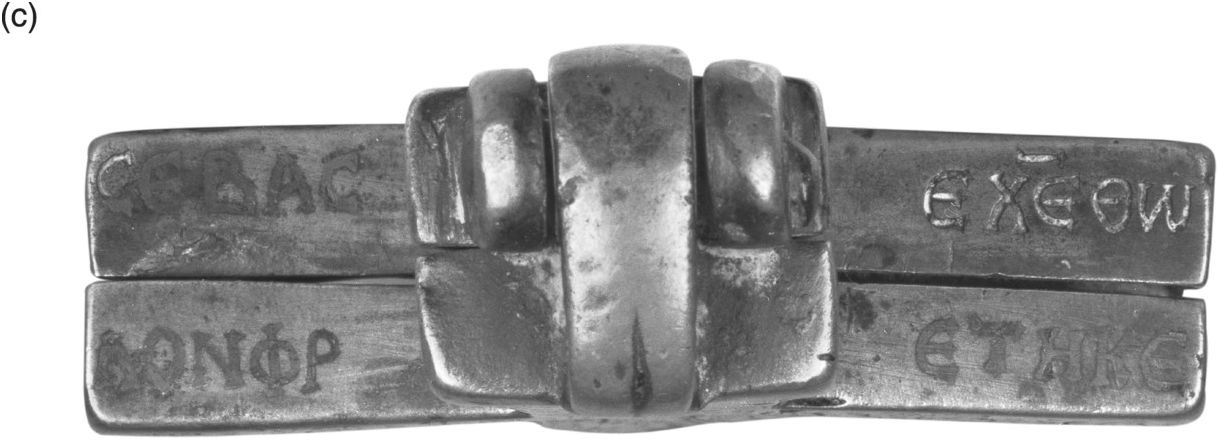

Figure 1.5a–d Details of the epigram on the pectoral cross-reliquary, ninth or tenth century, Saint Catherine’s monastery, Mount Sinai
Sometimes, however, inscribed artifacts present such a neat interlocking of text, image, and design that one must assume that the artist and the poet collaborated quite closely. This is the case with the ivory diptych in the treasury of the cathedral at Chambéry (Plate 2, Figure 1.6).Footnote 74 Variously attributed to tenth- or eleventh-century Constantinople or to the thirteenth-century Latin Levant in recent scholarship, the diptych is a remarkable object, not least because of its sheer size. A large elephant tusk was needed to yield its two leaves that measure 28.1 x 12.7 cm and have a thickness of no less than 1.5 cm. This fact alone clearly attests to the considerable financial resources available to the object’s commissioner. The diptych features a dense visual program, with figures and architectural and other details rendered in high relief or completely detached from the ground, the resulting effect being one of rich chiaroscuro. The centerpiece of the left leaf is an enthroned Mother of God with the Infant Jesus flanked by the princes of the apostles, Peter and Paul, and two attendant angels. The selection of narrative scenes above focuses upon the miracles and ministry of Christ: the Transfiguration is in the semicircular field at the top, while Christ teaching in the Temple, the Healing of the Blind Man, and the Healing of Peter’s Mother-in-Law occupy the horizontal zone below it. By contrast, the narrative scenes on the right leaf foreground the Passion and Resurrection of Christ: the badly damaged Crucifixion is at the top; the Entry into Jerusalem, the Anastasis, and Christ’s appearance to the holy women in the garden – the so-called Chairete – are arranged in the zone below; and a large and busy scene of the Ascension occupies the center of the leaf. Assembled in the lowest section of the diptych, on both leaves, is a file of saints. Eight of them – John the Baptist, Nicholas, Basil the Great, John Chrysostom, Panteleimon, Demetrios, George, and Theodore – are depicted as standing figures underneath an arcade. The remaining saints are portrayed en buste in a series of intertwined medallions at the very bottom. In addition to the four evangelists, they include Akindynos, Patapios, Cosmas, Damian, and Niketas. All scenes and figures on the diptych are neatly labeled. Contributing to this profusion of texts is a dedicatory epigram incised around the two leaves.
I depict you, O Lord, Creator of all things, in the arms of your Mother, as if upon the throne of the cherubim, representing all the events of your coming <on earth>, through which you saved mortals from every harm, driving the ailments away, O Word of God, with your word, and the terrors of the Passion and the Crucifixion full of dread, the self-effected Resurrection, the Ascension into heaven that is beyond comprehension. I, rhaiktōr, your faithful servant, beseech <you> through <the mediation of> those whom I have depicted for the sake of intercession with much desire.Footnote 75
The epigram represents a prayer addressed to Christ by the commissioner of the diptychs, who is identified only by the office of rhaiktōr he held. Depending on the date assigned to the diptych, this information can be interpreted in two different ways. If a tenth- or eleventh-century date is accepted, the commissioner must have been a high-ranking courtier in Constantinople. Should we subscribe to the view that the diptych dates from the thirteenth century, the commissioner was most likely a Westerner living in Outremer, either an ecclesiastical official in charge of a Latin religious or charitable house or a civil administrator in the service of the Venetian Republic.Footnote 76 For the purpose at hand, the questions of chronology and the patron’s identity are less relevant than the fact that the length, content, and physical layout of the epigram perfectly match the shape and iconography of the diptych. Each of the poem’s ten lines occupies the length of one clearly defined section of the frame. The epigram begins on the left leaf, with the first line running along the semicircular border of the arched top. The verses continue around the leaf’s rectangular frame, with each side of the frame accommodating exactly one line, in a sequence that was typical for Byzantine inscriptions displayed around rectangular fields: top–right–left–bottom.Footnote 77 The same arrangement is then repeated on the right leaf. In terms of their content, not only do the verses make direct reference to the imagery of the diptych, but they do so in a way that neatly corresponds to the distribution of individual scenes and figures on the object. Incised on the left leaf, the first half of the epigram points to the images carved on this leaf: the Virgin and Child (vv. 1–2) and the scenes of Christ’s miracles and ministry (vv. 3–5). Similarly, the second part of the epigram (vv. 6–8) on the right leaf highlights the themes of Christ’s Passion and Resurrection depicted there. The epigram ends with a reference to the saints assembled in the lowest section of the diptych (v. 9), whom the patron has introduced as his personal intercessors before Christ. It seems that, in laying out the verses on the frames of the two leaves, considerable care has been taken to physically juxtapose, wherever possible, specific words and phrases and the images to which they refer. Note how the words σταύρωσιν (“Crucifixion”), ἐξέγερσιν (“Resurrection”), and εἰς οὐρανοὺς ἔπαρσιν (“Ascension into heaven”) are placed right next to the relevant scenes, or how the phrase δι’ ὧν ἔγραψα πρεσβεύειν χάριν (“through <the mediation of> those whom I have depicted for the sake of intercession”) on the left border of the right leaf descends toward the solemn file of these very intercessors. Overall, the synergy of text and image in the Chambéry diptych is such that the poet and the ivory carver employed by the anonymous rhaiktōr must have worked quite closely on this object. As it would appear, the composition of the verses and the design of the diptych went hand in hand.
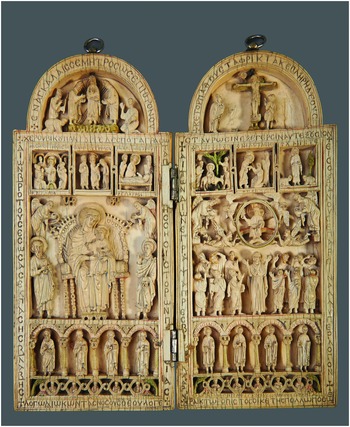
Figure 1.6 Ivory diptych, tenth/eleventh or thirteenth century, cathedral treasury, Chambéry
We know too little about the processes and mechanisms of artistic patronage in Byzantium to reconstruct in any detail the exact nature of interactions and negotiations that took place within the triangle patron–poet–artist. Was the patron always the engine behind the creation of an inscribed object? Or could the poet play a more fundamental role in this enterprise, beyond providing appropriate verses for the object or even collaborating with the artist on its design? Our sources are silent on this account, but it is possible that, in some instances, the poet could act as a liaison between the object’s commissioner and its maker. Byzantine artists and intellectuals often moved in the same circles. The fourteenth-century scholar and bureaucrat Michael Gabras, for instance, wrote letters to a monk-painter by the name of Gabriel.Footnote 78 Gabras’ younger contemporary, the writer Manuel Raoul, seems to have shared a decades-long acquaintance, if not friendship, with Gastreas, a painter active in the Byzantine Peloponnese. Raoul commissioned an icon of the Dormition of the Virgin from the painter in a letter tentatively dated to c. 1360, in which he recalled how diligently Gastreas had studied and copied ancient icons, including those showing the Dormition, twenty-six years before.Footnote 79
Particularly revealing in regard to the intermediary role that intellectuals could play in the field of artistic patronage and production is the correspondence of Maximos Planoudes. Several among Planoudes’ letters allow us to trace the contours of an intriguing network that connected artists and men of letters with powerful aristocratic patrons through personal ties of friendship and service. A key figure in this network was Melchisedek Akropolites’ relative by marriage, the pinkernēs Alexios Doukas Philanthropenos.Footnote 80 In 1293, this dashing young general was sent by Emperor Andronikos II Palaiologos to Western Asia Minor to fight the Turks. His meteoric success on the battlefield accorded him a heroic status among the local Greek populace, oppressed by the enemy, and eventually led him to stage an abortive coup that ended with his arrest and blinding on Christmas in 1295. The exigencies of warfare with the Turks did not prevent Philanthropenos from commissioning artworks in Constantinople. With the assistance of Planoudes, who resided in the capital, the pinkernēs employed a certain goldsmith to manufacture precious-metal revetments for some icons. As Planoudes reported in a letter, this proved to be a bad choice.Footnote 81 After receiving one-third of the promised reward – which, unfortunately, went unspecified in the letter – the goldsmith had mysteriously disappeared without a trace; his whereabouts were unknown even to his wife. Planoudes was, therefore, forced to ship the unadorned icons off to Philanthropenos. “Should it be God’s will,” he wrote, “when we see each other, you yourself will show me <these icons> furnished with adornment [κόσμον] as a sign of your reverence for the divine.”Footnote 82 It is tempting to speculate whether the icons in question were works of the monk-painter Isaiah, another member of the network emerging from Planoudes’ correspondence.Footnote 83 An acquaintance of Melchisedek and the pinkernēs Alexios, Isaiah was a man of some eminence, as can be deduced from the fact that the title kyr, meaning “lord” or “master,” was accorded to him.Footnote 84 He appears to have been an amicable person, willing to pull strings on behalf of his fellow artists. One of Planoudes’ letters to Philanthropenos is essentially a recommendation letter for a friend of Isaiah’s.Footnote 85
I write in regard to a monk-painter, a man excellent in art, irreproachable in character, moderate in spirit, someone who knows how to spread the word about a benefaction <received>. Although I had formerly been acquainted with this man, Lord Isaiah, who knows how to show affection to a fellow artist [φιλεῖν εἰδὼς τὸν ὁμότεχνον], introduced him <to me> and urged me to write to you on his behalf.Footnote 86
Planoudes then proceeds to explain the matter at hand. Some of the relatives of the unnamed monk-painter were forced to leave their home in the otherwise unidentified area of Tempsis (περὶ τὴν Τέμψιν) and settle in the Maeander valley, which, in the wake of his spectacular victories, Philanthropenos set out to repopulate with Greeks. Planoudes asks that these people be allowed to return to their home. Whether the monk-painter was given an opportunity to demonstrate his artistic prowess to the general is not known.
Thanks to their proximity to members of the Empire’s elite, Byzantine men of letters could and, as Planoudes’ correspondence demonstrates, did act as intermediaries between artists and high-placed patrons. Hence it is not inconceivable that, at times, they could also take care of artistic commissions on behalf of their powerful protectors and friends. In the above-mentioned triangle of actors that took part in the process of creating inscribed artifacts, the poet may occasionally have been the man in charge.
Epigrams and the viewer/reader
So far we have been concerned with the patronage and production of epigrams. Now we must turn to the questions of reception. Indeed, what kind of audiences did verses displayed on artifacts, monuments, and buildings address? How were such inscriptions read? Were there any specific occasions that called for the reading of epigrams? Were verse inscriptions necessarily read or could they engage their audiences in other ways?
On the most basic level, the readership of an epigram was determined by its setting. The verses displayed on the walls of great public churches could have been scrutinized by many, while those found, for instance, on a personal devotional object such as the Chambéry diptych or the cross-reliquary at Sinai spoke only to the chosen few who had the privilege of handling it. Written in an archaizing language, a form of Greek fairly removed from the spoken idiom, and often embroidered with scriptural quotations, references to classical and patristic authors, and borrowings from hymnography, Byzantine epigrams were addressed primarily to an educated audience. Their reach, however, was much broader, as the communicative potential of epigrams was not limited to the linguistic register.
To begin with, not all verse inscriptions were meant to be actually read. The famous porphyry column of Constantine still bears an elegant dodecasyllable couplet commemorating its restoration at the behest of Manuel I Komnenos.Footnote 87
Manuel, the pious emperor, restored this divine work, which time had defaced.
Inscribed on the column’s capital, at a height of over 30 m above the street level, the couplet is illegible from the ground (Figures 1.7 and 1.8). Even though inlaid lead originally enhanced the visibility of the inscription, an inquisitive passerby would hardly have been able to decipher the letters. If this is the case, then, what was the purpose of the inscription? Was this pithy proclamation of imperial munificence designed for divine rather than human eyes?Footnote 88 Or did the inscription have a prophylactic function, ensuring the stability of the restored column?Footnote 89
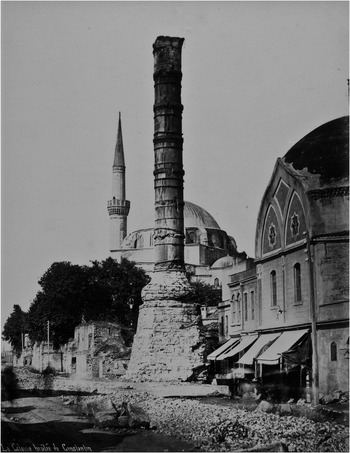
Figure 1.7 Porphyry column of Constantine, Constantinople/Istanbul
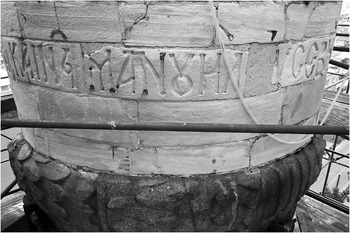
Figure 1.8 Detail of the porphyry column of Constantine with the dedicatory epigram of Manuel I Komnenos, Constantinople/Istanbul
Confronted with such inscrutable inscriptions, one should bear in mind that in Byzantium publicly displayed texts had a powerful visual presence. Their significance and impact extended beyond basic linguistic communication. Several factors contributed to this. As a religion of the Incarnate Word of God propagated through a set of sacred texts, Christianity ensured that the Byzantines assigned a special place to the written word in their culture. Writing was associated with the sacred and perceived as a vehicle of truth and knowledge.Footnote 90 Besides, since the Empire of the New Rome was to a large extent a bureaucratic state, the proper functioning of which was predicated upon the production and circulation of large quantities of written documents, writing was a quintessential index of power and authority in the Byzantine mentalité.Footnote 91 But the prestige enjoyed by the written word had another, no less significant facet. Writing was also connected with magic. Byzantine magical amulets commonly feature texts of different kind, including spells, invocations, and divine names, but also mysterious inscriptions in the form of clusters of unintelligible figures and letter-like signs known as charaktēres.Footnote 92 Such texts were considered inherently potent, capable of exerting a tangible impact in one’s life by driving away demons, effecting cures, or securing protection from sorcery and other harms. Monumental epigraphy, too, harbored supernatural forces. In the so-called Parastaseis Syntomoi Chronikai, a compilation of stories, datable to the eighth century, about the monuments of Constantinople, ancient inscriptions figure not so much as epigraphic traces of the past, but as conveyors of cryptic and potentially dangerous messages.Footnote 93
The deeply ingrained belief in the symbolic and mystical significance of the letters of the Greek alphabet further contributed the status and power of the written word. Bringing together several strands of pagan, Jewish, and Early Christian thought, this belief held that the letters were not simple conventional signs, but symbols pregnant with religious, cosmological, and other meanings, which may be uncovered by analyzing their visual form, their place in the alphabet, and their numerical value.Footnote 94 Thus, according to the anonymous sixth-century treatise On the Mystery of the Letters, the letter Δ, for example, stands for the totality of the created world.Footnote 95 The hierarchy of the universe is encoded in the closed triangular form of this letter; its broad horizontal base represents the lower parts of the world – the earth and the waters above and below it – while its tent-like top points to the heavenly realm. The letter’s triangular form moreover evokes the Holy Trinity, and its numerical value – four – signifies the four elements, the four cardinal points, the four winds, the four seasons, the four great rivers, the four humors of the body, as well as the four evangelists.
Verse inscriptions displayed on Byzantine artifacts and buildings partook of the multifaceted power of the written word. For an illiterate or semi-literate audience, incapable of grasping the message of an epigram, the extralinguistic connotations of writing would provide a basic frame of reference for accessing the inscribed text.Footnote 96 In a sense, to fathom the message of an epigram, the viewer did not necessarily have to read it. Byzantine verse inscriptions possessed what Brigitte Bedos-Rezak has called in a different context “non-literate legibility.”Footnote 97 Their communicative potential resided not only in their verbal message, but also in their letterforms, graphic structure and material fabric, the placement and spatial arrangement of the text, as well as in the interplay between the text and its physical context. We shall explore these aspects in greater detail in Chapter 4. For the moment, one example should suffice to illustrate the crucial role played by the visual presentation of epigrams in the construal of their meaning.
The church of Saint Nicholas near the village of Platsa in the Mani in the Peloponnese preserves a long dedicatory inscription in verse (Figures 1.9 and 1.10; see also Figures 4.15 and 4.16).Footnote 98 The inscription informs us that this unassuming three-aisled basilica with a dome was restored and decorated with frescoes in 1337/38 by the tzaousios Constantine Spanes, the military governor of the highland region around Mount Taygetos, at that time inhabited by a Hellenized Slavic tribe known as the Melingoi.Footnote 99 Painted in black in accented capital letters, the inscription runs in a horizontal band around the nave. It starts on the north wall, at a height of about 2.60 m above the ground, continues into the sanctuary, and ends on the south wall. In all likelihood, few of the worshippers flocking to this remote provincial shrine would have been able to read the verses, which in an elevated and rather tortuous language celebrate Spanes’ renovation of the church. But to an illiterate audience, the inscription’s visual dimension effectively compensated for the lack of legibility. The expressiveness of the lettering, with its concatenation of strong vertical strokes, does not fail to impress the eye. Besides, the very manner in which the verses are displayed on the walls would have allowed the viewer to set them apart from countless prose dedications encountered in other churches of the Mani and elsewhere, which are typically located either above the main entrance or in the sanctuary apse.Footnote 100 What is more, the verses are not simply arranged in a linear fashion. The horizontal band they occupy represents a painted imitation of a cornice carved in stone. The slightly darker strip in the band’s upper part is meant to create the illusion that the letters of the inscription are inserted, if not carved, between two protruding horizontal moldings, so that the one above them casts a shadow. Carved marble cornices of this kind, bearing poetic inscriptions, were a feature of great Constantinopolitan churches such as those of Saint Polyeuktos and Saints Sergios and Bakchos (Figure 1.11).Footnote 101 In the provincial Peloponnese, the painted rendition of such a cornice must have been something of a curiosity evoking associations with the splendor of metropolitan monuments. Thus the communicative power of the dedicatory epigram in the church of Saint Nicholas was not limited to its verbal content, but also embraced the visual presentation of the text. A visitor to Spanes’ foundation did not have to actually read the verses encircling the church interior in order to grasp their message. The tzaousios – it was evident – was a man of means, ambition, and refined taste.
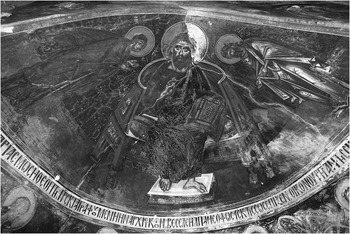
Figure 1.9 Sanctuary apse with the Deēsis and a section of the dedicatory epigram of the tzaousios Constantine Spanes, 1337/38, church of Saint Nicholas, Platsa in the Mani
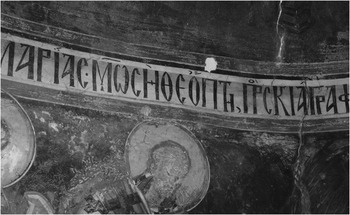
Figure 1.10 Detail of the dedicatory epigram of the tzaousios Constantine Spanes, 1337/38, church of Saint Nicholas, Platsa in the Mani
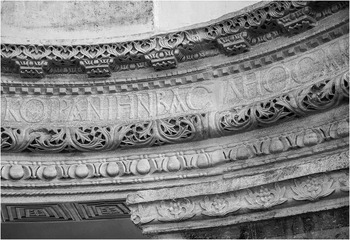
Figure 1.11 Detail of the dedicatory epigram of Justinian I and Theodora, mid-520s, church of Saints Sergios and Bakchos, Constantinople/Istanbul
If a literate viewer examining an edifice or artifact was curious enough to read the verses inscribed upon it, he or she would most likely do it aloud. As has been convincingly argued, silent reading was not a standard practice in Byzantium. From monumental epigraphy to books and letters, the written word was often, if not normally, read viva voce.Footnote 102 In the case of verse inscriptions, oral delivery is virtually a function of their poetic form. To comprehend and fully appreciate the rhythmical structure of an accentual meter such as the dodecasyllable, one has to hear it. Thus it is no accident that, in a poem addressed to a patron, Manuel Philes should call attention to his poetic skill in the following manner:Footnote 103
Having strung together threads fitting for you, I shall skillfully knit a splendid cloak of beats/rhythms, which not even all of time could destroy.
Based on the trope of text as textile, Philes’ comparison of his verses to a garment fashioned from krotoi, meaning “beats” or “rhythms,” undoubtedly alludes to their vocal recitation.Footnote 104 In Byzantium, poetry was typically written with a view to oral delivery and experienced as performed speech. The same holds true for metrical inscriptions. Seemingly mute in their material fixity, inscribed verses would have been, quite literally, given a voice each time an inquisitive viewer took the trouble to recite them. Hence, numerous references to the ear, mouth, lips, and hearing in Byzantine epigrams should not be understood as merely figurative. They are indicators of the actual reading practice.Footnote 105
At times, epigrams make explicit reference to oral performance. A case in point is an epitaph composed by Philes to accompany a funerary portrait of a certain prōtoïerakaria Melane.Footnote 106 Following a device common in funerary inscriptions, the poet presents the dead woman directly addressing the viewer.
So that, by beholding a shadow [i.e., Melane’s portrait], everyone may learn from this not to be desirous of the <earthly> life, I paint for you, O stranger, a portrait of myself; for I shall borrow <the faculty of> speech from the living, which nearly endows me with the power of breathing.
In an extended memento mori, Melane then proceeds to recount the facts of her bygone life to the viewer standing at her tomb. Her monologue constitutes a verbal self-portrait. It is notable that, in the quoted excerpt, Philes uses the verb ζωγραφέω – literally meaning “to paint from life” – in reference to Melane’s depiction of herself. This discursive painting “from life” is implicitly contrasted with the pictorial portrait of the deceased, which the poet disparages as a mere shadow. What breathes life into Melane’s verbal self-portrait is the voice borrowed from the viewer. By reading aloud Melane’s monologue, he or she would literally lend voice to the dead woman and, by implication, animate the speechless image displayed at her tomb.Footnote 107
The oral delivery of epigrams could take place at any given moment, essentially whenever a literate viewer approaching an artifact or a monument was sufficiently intrigued to read the verses inscribed upon it. Certain occasions and venues, however, seem to have been particularly well suited for the recital of epigrams. To reconstruct such performative situations is no easy task, as the available evidence is sparse and for the most part circumstantial. Nonetheless, some general propositions can be advanced.
To identify the moments when an epigram was likely to have been read aloud, one must, of course, consider its function and physical setting. In the case of epitaphs, for instance, it is reasonable to assume that their vocal performance was tied to the ritual commemoration of the dead.Footnote 108 Byzantine custom dictated that, following the burial of a person and the forty-day postmortem period during which, according to tradition, the soul would gradually separate from the body, relatives and friends of the deceased would regularly assemble at his or her tomb in remembrance, most notably on the anniversary of the person’s death.Footnote 109 These commemorative gatherings furnished an ideal context for the recitation of the verses displayed at the tomb. Assuming that Philes’ epitaph on Melane was inscribed next to her funerary portrait, which is by no means certain, the performative animation of this mute image by the voice borrowed from the viewer is likely to have coincided with and was an aspect of the commemoration of the departed prōtoïerakaria.
The solemn performance of epigrams appears to have taken place in conjunction with annual commemorative rites in other contexts too. The manuscript record preserves an anonymous poem, 145 dodecasyllable lines in length, on the monastery of Christ Pantokratōr in Constantinople founded by the emperor John II Komnenos and his wife Irene-Piroska.Footnote 110 Dwelling upon the physical structure and organization of this imperial establishment, the poem describes in considerable detail its splendidly appointed churches, the monks’ quarters, its lush garden and circuit of walls, its hospital and old-age home. The verses lavish praise upon the imperial couple, highlighting in particular the role of the empress – already dead at the time – in founding the monastery. The poem’s title indicates that this lengthy text was recited annually on August 4, the day when the official inauguration of the Pantokratōr was commemorated.Footnote 111 Thanks to a sixteenth-century source, we know that at least the beginning of the poem, and most likely all of its 145 verses, once adorned a wall in the monastic complex.Footnote 112 This inscription must have served as a focal point in the course of the festivities marking the monastery’s inauguration day. We may assume that every year, on August 4, a group of monks and visitors would congregate in front of the inscribed verses to listen to their recitation. Similar ceremonial readings of dedicatory epigrams could have taken place in other monastic houses and ecclesiastical institutions in commemoration of their founders and benefactors.Footnote 113
Different contexts could generate different performative situations. Turning to epigrams inscribed on objects intended for liturgical or paraliturgical use, one may reasonably ask whether their oral delivery was occasionally integrated into the ritual. Consider, for instance, the now-lost steatite panagiarion of Alexios Komnenos Angelos from the Panteleimon monastery on Mount Athos (Figure 1.12).Footnote 114 This intricately carved dish was used for the so-called Elevation of the Panagia, a paraliturgical rite in honor of the Virgin, which involved the sanctification of a piece of bread known as παναγία (“all-holy”) after one of the more common Marian appellations in Greek.Footnote 115 The core elements of the rite were quite simple. To sanctify the bread, the celebrant invoked the name of the Holy Trinity and appealed to the help and intercession of the Mother of God while lifting – and hence, “elevating” – the bread on his fingertips. Believed to secure the Virgin’s protection, the sanctified panagia was consumed just like the Eucharist. Indeed, partaking of the panagia could even serve as a substitute for the Holy Communion. Significantly, the rite of the Elevation was not a prerogative of the clergy, as even the laity could perform it. During the Palaiologan era in particular, special containers, or panagiaria, used for the celebration of the rite appear to have become quite popular as personal devotional instruments among members of the lay elite. The steatite dish from the Panteleimon monastery is one of the more exquisite representatives of this category of objects.
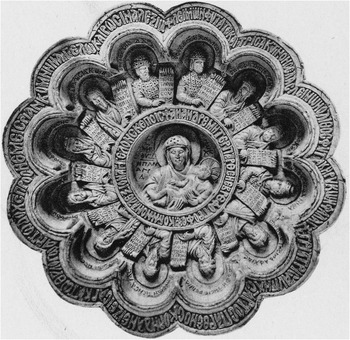
Figure 1.12 Steatite panagiarion of Alexios Komnenos Angelos, fourteenth century, formerly in the Panteleimon monastery, Mount Athos
The panagiarion features a medallion with the Virgin and Child in the center surrounded by a row of prophets, each with an unfurled scroll in his hands, in an arrangement that curiously recalls the decoration of a church dome. Complementing the figural imagery of the dish are two metrical inscriptions, both meticulously and painstakingly carved rather than incised – a feature that in and of itself contributes to the object’s preciousness. The epigram encircling the central medallion voices a plea on behalf of one Alexios Komnenos Angelos, the original owner or possibly donor of the panagiarion.
O Mother without a husband, O Virgin nourishing an infant, may you protect Alexios Komnenos Angelos.
The second epigram running along the lobed border evokes the imagery, materiality, and ritual function of the object.
A meadow and plants and light with three rays. The stone is the meadow, the phalanx of prophets are the plants, the three beams are Christ, the bread, and the Virgin. The Maiden lends flesh to the Logos of God, and Christ by means of bread distributes salvation and strength to Alexios Komnenos Angelos.
Prompted by the green color of steatite, the anonymous poet has transformed the panagiarion into a vision of a verdant meadow bathed in a mysterious light. Presenting the carved dish as a visual enigma, the verses encourage the viewer to approach it with feelings of wonder and awe. What is significant for our purpose is that this encounter with the object is explicitly envisioned as taking place within the ritual context. The verses assume that the viewer sees a piece of bread, the panagia, inside the dish. This indicates that the optimal moment for the reading of the epigram was during or immediately after a performance of the Elevation. Of course, it could be argued that the reference to bread in the text is a generic one, intended simply to highlight the object’s function. But the insistence on the presence of the panagia inside the dish could also be taken to signal that the two inscriptions were integrated into the ritual. The recitation of these verses would not only enhance the solemnity of the Elevation; it would also personalize the rite by adding to it poetic pronouncements on behalf of Alexios Komnenos Angelos. If this individual was the first user of the panagiarion, as seems reasonable to assume, then the message of the inscriptions would have been sounded in his own voice.
Inscribed devotional artifacts designed for personal use seem to have invited such privately staged performances. It is easy to imagine, for instance, the anonymous owner of the Chambéry diptych addressing his prayer to Christ in the words of the epigram incised on the frames of the diptych’s ivory leaves (Plate 2, Figure 1.6). But what about artifacts – icons, reliquaries, textile hangings, and the like – donated to religious houses? Did any particular occasion call for the reading of metrical texts placed upon them? One obvious possibility is the moment of the presentation of the gift. Although no such presentation is described in the sources, it stands to reason that this event could have been staged as a small ceremony in which the donor or his or her representative would read the inscription before an audience. Alternatively, the presentation of the gift could have been a more private affair, conducted in front of an icon of the holy figure to whom the gift was offered. Since dedicatory epigrams often take the form of a personal prayer addressed to Christ, the Virgin Mary, or a saint, their recitation may well have been staged for the eyes and ears of the gift’s sacred recipient, who would attend the ceremony through the medium of his or her image.
As Foteini Spingou has argued, performative epigrams in the narrow sense – that is, epigrams that appear to have been composed to be recited rather than inscribed – were likely delivered following the same or similar scenarios.Footnote 116 If they accompanied gifts, be they religious or secular, they could have been performed at the moment of the formal presentation of the gift. In cases when the donor was unable to present the gift in person, the performative epigram escorting the gift could be sent in a letter and recited upon its receipt. Spingou tentatively suggests that, in some instances, the recited text may even have been copied on a piece of paper and placed next to or inside the donated object. Thereby, the text’s link with the object would acquire a more permanent, material form.
An important parallel for the ceremonial performances of epigrams – both inscriptional and performative in the narrow sense – postulated here is provided by the genre of recited metrical prologues to homilies. This genre of Byzantine poetry encompasses poems composed to introduce the public reading of homilies and occasionally hagiographical texts, too, in the course of religious services and feast-day celebrations in churches and monasteries.Footnote 117 The performative function of these poems is clearly indicated by characteristic apostrophes to the officiating priest – σὺ δ’ ἐπευλόγει, θύτα (“And you, priest, give blessing!”) is a common formula – with which many of them end. Following the delivery of such a poetic introduction, the priest would give his blessing, and the recitation of the main text could begin. Metrical prologues are strikingly similar to performative epigrams, as defined by Spingou. Not only were these two categories of texts written specifically for oral presentation, but they also functioned as poetic parerga. Rather than being autonomous literary pieces, they accompanied other entities – physical objects in the case of performative epigrams, texts in the case of metrical prologues.
The manuscript record yields considerable evidence that, on certain occasions, the composition and performance of epigrams coincided. Philes’ poetic corpus contains a poem devoted to a ring that voices the same kind of sternly moralizing view of gold jewelry as the couplets the poet penned for the ring of Michael Senachereim Monomachos.Footnote 118 What is unusual about this poem is that each of its twenty-five dodecasyllable verses represents a complete, self-contained poetic statement which could readily serve as a one-line metrical inscription on a ring; in only one instance are two consecutive verses combined to form a couplet (vv. 7–8). This oddly disjunctive concatenation of what are essentially independent epigrams did not originate as an extensive set of trial pieces, written to order and subsequently strung together, but rather as a demonstration of the poet’s virtuosity. This is indicated by the title attached to the poem, which reads: Εἰς δακτύλιον αὐθωρόν, literally meaning “<Verses> on a ring <composed> on the spot” or “instantaneously.” The poem, in other words, was improvised.Footnote 119
The ability to produce elevated discourse extemporaneously, either in verse or in prose, was a skill highly valued by the Byzantines.Footnote 120 Judging by the number of his poems that are described in the appended titles as having been delivered authōron, Philes was a master of improvisation. Most of these literary works were recited in religious and ceremonial contexts and include metrical prologues to sermons and commentaries on scriptural passages as well as solemn addresses to the emperor on the occasion of feast-day celebrations.Footnote 121 Whether they were truly improvised on the spot or drafted beforehand, in anticipation of their public delivery, and to what extent their present form is the result of the subsequent reworking of the original offhand compositions is ultimately less important than the fact that Philes was given to parading his dazzling literary skill in impromptu performances. It is significant that the poet’s improvisations occasionally concerned works of art. One was, for instance, inspired by an image of a lion depicted ἐν τῇ γῇ, that is, “on the ground,” most likely a late antique floor mosaic, perhaps similar to the mosaic of the Striding Lion from Antioch (Figure 1.13).Footnote 122
Being fortunate to have a steadfast spirit, the painter has depicted a lion without fear. This is, indeed, strange; but what is even stranger is that he almost endows the image with life [literally, ‘breath’], stirring up the beast held fast by means of painting.
This playful poetic variation on the theme of the lifelikeness of art could easily pass as a verse inscription attached to a naturalistic representation of a lion as much as the individual lines of the authōron-composed poem on a ring could be imagined displayed on actual pieces of jewelry; in both instances, Philes was improvising epigrams. But what was the context for such epigrammatic exercises? Did they, perhaps, take place in the presence of a prospective patron as a vivid proof of the poet’s mastery of the genre? This is certainly a possibility. When an aspiring writer by the name of Leo Megistos made obeisance to the megas hetaireiarchēs George Palaiologos with a view to entering this magnate’s service, he was subjected to a test: to demonstrate his credentials, Leo was ordered to improvise a poem on a stone relief with a depiction of the Muses, presumably a piece of ancient sculpture in Palaiologos’ possession.Footnote 123 The epigrams improvised by Philes may well have served a similar purpose as a kind of examination essays. It is equally possible, however, that the poet’s extemporaneous versifying took place before a small audience of discerning patrons, fellow-writers, or friends. It is not difficult to imagine a group of art lovers, gathered to admire a tessellated pavement in an aristocratic residence or, perhaps, in the imperial palace, which the poet would regale by reciting a few off-the-cuff verses on the mosaic image of a ferocious lion displayed under their feet.
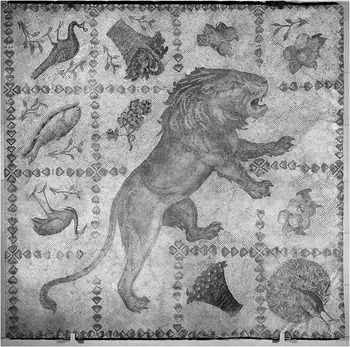
Figure 1.13 Mosaic of the Striding Lion, fifth century, The Baltimore Museum of Art, Baltimore
Such an impromptu performance would have resembled those literary recitals to which Byzantine authors refer as theatra.Footnote 124 This rather flexible term designates a range of performative events and venues, from solemn declamations held at court or delivered in a church to more private literary gatherings in the houses of the aristocracy, presided over by a sophisticated patron of letters, to informal reading circles of intellectuals and schoolmates. As a social institution, theatron played a key role in the production and reception of highbrow literature in medieval Byzantium. While, in essence, the recitation and discussion of literary texts was their primary purpose, Byzantine rhetorical theatra were not reading clubs in the modern sense. Rather, they were quite vivacious, colorful assemblies with a great deal of shouting and booing, clapping of hands and stamping of feet, sometimes accompanied by songs and music. With an affectation befitting the cultural exclusivity of these gatherings, some authors even compared them to Bacchic orgies and Corybantic mysteries.Footnote 125 Rhetorical “theater” was a natural setting for the performance of improvised discourse. We know, for example, that Michael Italikos made a show of his eloquence by extemporaneously delivering a speech in honor of his patroness, Irene Doukaina, widow of Alexios I Komnenos, in a theatron held by the empress.Footnote 126 The improvisation of epigrams would be perfectly at home at such a venue. Indeed, one could go a step further and argue that the recitation of epigrams in general, not just improvised verses, may occasionally have been staged in a theatron. Spingou has already made this suggestion with regard to specifically performative pieces.Footnote 127 Granted, no Byzantine source that I am aware of mentions the recitation of epigrams in a theatron. But this scenario seems plausible. As we have seen, Maximos Planoudes in his letter to Melchisedek Akropolites makes an allusion to the future critical assessment of his hexameters on the icon of the Last Judgment, which may well have been pronounced in a theatron frequented by the addressee. It is perhaps not accidental that in the opening line of the first epigram on the icon, the one devoted to the vision of the heavenly tribunal presided over by Christ, Planoudes uses the word theatron: Ὦ κρίσις, ὦ στάσις, ὦ φοβερώτατον αὖ τὸ θέατρον (“Judgment! Assembly! Formidable spectacle [literally, ‘theater’]!”). By the choice of this word, Planoudes quite possibly implies in a playful fashion that, just as every human soul will be judged at the eschatological theatron, so will his hexameters on the icon receive critical appraisal at a no less terrifying tribunal consisting of Melchisedek’s learned friends.
The evidence regarding the specific performative situations in which epigrams were or could have been recited is admittedly too sparse to allow for much certainty. The foregoing discussion has accordingly yielded hypotheses rather than firm conclusions. What seems certain, however, is that the act of reading an epigram was often a performative event, sometimes communal in nature, in which a text inscribed on an object or written on a page would come alive as speech, a dynamic flow of sounded rhythmical lines. Whether written in ink or carved, hammered, embroidered, or painted, epigrammatic verse was experienced both visually and aurally. It appealed to the eye and the ear alike.



